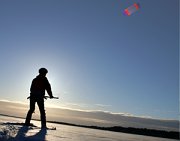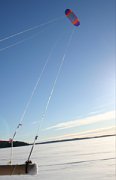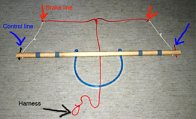Kite skiing and kite skating
My kiting career started with using a single-line 1 square metre kite to propel a kayak.
This was reasonably successful, so I had high hopes for the ostensibly easier task of propelling myself on ice skates on natural ice,
but I discovered that the low friction and mass involved means that you reach windspeed very quickly, the apparent wind drops to zero,
and then the kite falls out of the sky.
So it turns out that slow, heavy sports benefit more from simple kites than fast sports.
 For faster sports I bought a used 3.3m2 Flexifoil Blade 4-line kite, with 30m lines. It's not water-relaunchable, so I don't know when
(if ever) I'll be good enough to use it in a kayak or with a board, but it is very controllable and has plenty of power for
ice skating or skiing, and having multiple lines it can also be used to tack against the wind.
I tried it on land and found that I had to run with it in a 4m/s (10mph) wind, and did involuntary jumps.
For faster sports I bought a used 3.3m2 Flexifoil Blade 4-line kite, with 30m lines. It's not water-relaunchable, so I don't know when
(if ever) I'll be good enough to use it in a kayak or with a board, but it is very controllable and has plenty of power for
ice skating or skiing, and having multiple lines it can also be used to tack against the wind.
I tried it on land and found that I had to run with it in a 4m/s (10mph) wind, and did involuntary jumps.
The next step was to take it out on ice skates, and I was lucky to get a day when the lake was covered in pure, smooth black ice
with wind of about 1m/s. The kite behaved very well and was easy to hold using the normal control handles, since the friction was so low that
any force on my arms was immediately converted into movement. I didn't go fast, but then the wind was barely a breeze.
 It was a good initiation, except that despite keeping hundreds of metres away from everyone else, some guy got curious and came
over to see what I was doing, and skated straight over my lines, cutting one and damaging the others. So I now have a knot 5m into one
of the control lines, which always gets tangled.
It was a good initiation, except that despite keeping hundreds of metres away from everyone else, some guy got curious and came
over to see what I was doing, and skated straight over my lines, cutting one and damaging the others. So I now have a knot 5m into one
of the control lines, which always gets tangled.
The next time out was real snow kiting on touring skis, with about 1cm of
light snow covering the ice, -2 deg C, and a wind of 4-5m/s (10mph).
Now the forces on the lines were much higher, so I used a homemade control bar that hooks on to a windsurfing harness,
with a safety line that applies the brakes if I drop it. The feeling was much like that of waterskiing, and as with that sport,
I was surprised that there was no tendency to tip forward on to one's face. For that reason the free-heel skis worked just as well
as slalom skis, and were much easier to manoever with when the kite was down. On the other hand mine had bad edges, and I felt that I couldn't tack as
high as I would have liked. Still, I reached 35 kph (22mph) on a reach, and was pretty much keeping up with the other guys who were on up to 16 m2
inflatables. They must have had vastly more power available, but that apparently wasn't the limiting factor in these conditions.
They also appeared in pairs, each carrying a huge backpack, and had to make an encampment where they spent half an hour
rigging and adjusting. I arrived with my normal 35l pack, and could rig and launch alone in 5 mins. Their kites must be great on water,
but seemed to have a lot of overheads on land. Mine weighs around 1kg with the wooden control bar, and has a volume of maybe 5 litres,
so it would be quite reasonable to take it on a long tour. Imagine the distances you could cover compared to trudging with a sled.

The third time out was on 5cm of wet snow, +/- 0 deg C, with 5-7m/s (10-15mph) wind and heavy snowfall. Not ideal conditions, and I tried
slalom skis to help deal with the heavy snow, but regreted it. Still, things went OK to start with, but then the kite became harder to control,
especially after an inverted crash, when it wouldn't back up and spin as it should. After several hours of struggling I discovered the reason -
snow had collected in the open cells, and packed itself into perfect snow balls about 7cm in diameter, so there was more than a kilogram
of ballast moving around. I was amazed that it flew at all. But I guess you shouldn't fly an open cell kite in snowfall, and probably not rain either.
It was also very difficult to get the hard-packed snow out through the mesh, and I eventually gave up and took it home to melt and dry in the shower.
The next trip was rather frustrating with the wind dropping to 2m/s, but at least I could take the rather static pictures you see here.
Then I was out in 5-8m/s (10-18mph), gusting and changing direction rapidly, and the surface alternating between 20cm wet snow and raw, uneven ice. Mmmm.
I got up to 40 kph (25mph) on a reach, but crashed badly as I hit rough ice whilst edging too hard. It was also hard to launch, as the control
lines would catch on sastrugi, thus reducing and unbalancing the effect of brake lines. This would cause a spin, and once the spin had
started in one direction, it seemed that the uneven tension was trapped by the twist, and the spin would continue until I managed to ski
to the kite and grab hold of it.
Update 2005:

At New Year the small lakes around Uppsala were covered in beautiful fault-free black ice,
and a 4m/s wind gave perfect conditions for very fast but controllable kite skating,
and I could easily tack at least 20 degrees up wind. Unfortunately I let a
friend try, and when he put the kite down he then skated over the lines,
but luckily not cutting
all the way through, as a second knot would be a big problem when it bumped into the first. I patched up the scars with superglue, and they are holding up so far.
Then I had a day skating with 6-8m/s wind on soft ice (+1 deg and cloudy), with 2cm of
damp snow on top. The snow wasn't a hinderance, but the soft ice was a bit slow.

Still, I managed to get up to 50km on a reach.
I used the control bar because it was already set up, but handles would have been just as good, as I didn't need a harness.
The biggest problem was the
kids driving their snowmobiles and mopeds round and round the lake, who after
getting bored with terrorising the toddlers learning to skate, decided to use
me as a slalom post instead. Every time I had to drop the sail to avoid
decapitating them it picked up
some snow in the outer cells, and eventually got uncontrollable because of the
resulting snowballs.
 Finally, a good day on the ice : -5 deg C, sun, and a constant 4m/s wind.
That's not enough wind for speed records, but I cruised 25km at around 40km/h,
which was great, and I managed to practice precision flying, skimming the kite
along 20cm above the ice for hundreds of meters.
Finally, a good day on the ice : -5 deg C, sun, and a constant 4m/s wind.
That's not enough wind for speed records, but I cruised 25km at around 40km/h,
which was great, and I managed to practice precision flying, skimming the kite
along 20cm above the ice for hundreds of meters.
And now a good day on snow : -2 deg C, smooth nevè, sun, and 4-6 m/s.
Still not record-breaking wind, but I easily reached 40km/h again on telemark skis, which is
curious given the much greater friction there must be on the skis. I guess
power wasn't the limiting effect. And the guys on the big kites were
reporting similar speeds. The jumper you see here was on a 10m2 kite.
The control bar :

Although the normal control handles work well on skates, on skis I found it much better to
use a windsurfing harness and the homemade control bar. Control wasn't quite as precise and
fast, but it was much easier on the arms. The bar is wooden, about one metre long, and the
control lines are chicken-looped on to short string stubs going through the bar. Longer pieces
of string extend out to the brake lines, so that when they are attached they have no tension
in normal flight (the kite effectively becomes a two-liner). Then the red T-shaped line connects
to the brake lines, and the long end is attached to the harness to become a safety line -
if you drop the control bar and the kite tries to fly away, the brake lines are automatically pulled
and the kite stalls. When launching the kite alone, the brake yoke can be fixed to an ice screw fixed in the ice.
If the kite crashes upside down and you need to fly in reverse, you can pull directly on the
red yoke with your hands. Pulling slightly lopsided then causes a spin, and quickly dropping the
brake line after 180 degrees sets the kite flying off normally.
Since the picture was taken, I have made the bar foldable by sawing it in half and joining the
halves with a piece of PVC pipe, held in place with cotter pins.
© Mark Harris Feb 2006
(More outdoor pages)
(MRH homepage)
 For faster sports I bought a used 3.3m2 Flexifoil Blade 4-line kite, with 30m lines. It's not water-relaunchable, so I don't know when
(if ever) I'll be good enough to use it in a kayak or with a board, but it is very controllable and has plenty of power for
ice skating or skiing, and having multiple lines it can also be used to tack against the wind.
I tried it on land and found that I had to run with it in a 4m/s (10mph) wind, and did involuntary jumps.
For faster sports I bought a used 3.3m2 Flexifoil Blade 4-line kite, with 30m lines. It's not water-relaunchable, so I don't know when
(if ever) I'll be good enough to use it in a kayak or with a board, but it is very controllable and has plenty of power for
ice skating or skiing, and having multiple lines it can also be used to tack against the wind.
I tried it on land and found that I had to run with it in a 4m/s (10mph) wind, and did involuntary jumps.





